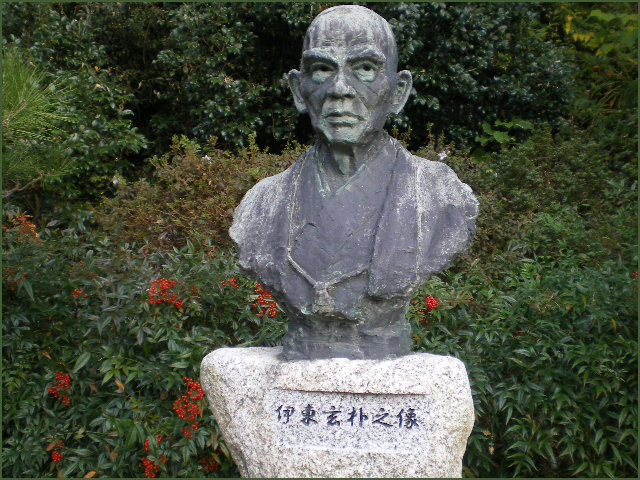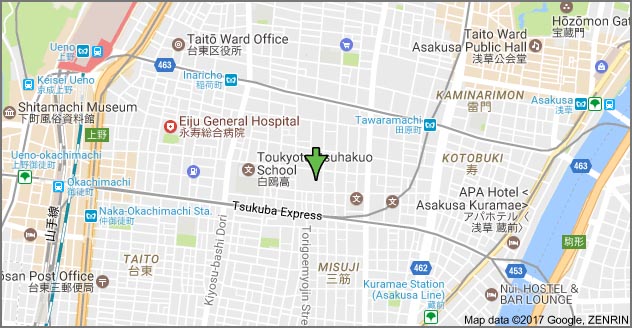- Yōkai 妖怪 Yokai monsters - - ABC-Index -
::::::::::::::::::::::::::::::
Ino Heitaro 稲生平太郎 and Gonpachi 権八(Gompachi)
The year is 1749. The place is 三好市 広島県 Miyoshi town in Hiroshima.
Heitaro was a samurai of the domain.
He and his friend Gonpachi tried a contest of courage, involving an encounter with various Yokai.
This was a popular summer game reminding people of the
. Hyakki Yagyō 百鬼夜行 "The Night Parade of a Hundred Demons" .
In May they went up to 比熊山 Higumayama and lit 100 candles. Now each one of them had to tell a Yokai ghost story and after each story, one candle was put out.
After the last story was told the last candle was blown out and the two waited in the darkness for any Yokai to make their appearance.
Anyway,
no Yokai appeared for some time that night, so they went back home. But come July, the monsters begun to appear to haunt them . . .
And this story is told in the famous
稲生物怪録 The Ghost Experience of Mr. Ino
- いのうもののけろく Ino Mononoke Roku
- いのうぶっかいろく Ino Bukkai Roku

CLICK for more spooky photos !
For one month, various Yokai appeared day and night, trying to frighten Heitaro, but he never lost his calm and slept well at night.
For example, a huge toad appeared in his cupboard in the evening, with a red rope around its body . . . so Heitaro grabbed the rope and slept . . .
The next morning, the toad showed its real appearance, just the usual big box for cloths in the cupboard.

Another evening, a woman with a long neck came out of the Tokonoma niche from his room
and tried to lick him all night.
But he just ignored her completely and slept well till morning.

Eventually the Yokai gave up, praised his fearlessness and - in a swoop - disappeared from his garden.
This story soon became a picture scroll for all to enjoy.
稲生物怪録絵巻 Ino Mononoke Roku Emaki.
..............................
- quote - YOHEI IZUMIDA -
Spooky 'yokai' ghost museum to lure tourists to Hiroshima

An illustration from "Hyakki Yagyo Emaki," a narrative scroll painting depicting a parade of yokai (Provided by the city government of Miyoshi, Hiroshima Prefecture)
MIYOSHI, Hiroshima Prefecture--
An enthusiast's extensive collection of paraphernalia related to the "yokai" supernatural beings of Japanese folklore is to be housed in its own museum as part of efforts to attract more visitors here.
The city government decided to construct a purpose-built museum to showcase about 3,000 yokai items amassed by Koichi Yumoto forming the main attraction. The museum is scheduled to open in 2018.
"I want to hand down to posterity Japan's original culture generated by Japanese people's imagination," Yumoto, 66, of Tokyo's Edogawa Ward, has said.
He started collecting yokai-related works of art about 30 years ago, and has spent more than 100 million yen ($882,450) on his hobby to date.
The collection includes precious items, such as "Hyakki Yagyo Emaki," a narrative scroll painting depicting a parade of yokai, and the renowned ukiyo-e artist Katsushika Hokusai's spooky tale-themed "nishiki-e" multicolored woodblock print "Hyaku Monogatari" (100 stories).
Miyoshi, located in a mountainous region, has been seeking ways to revitalize itself by taking advantage of the local "mononoke" evil spirits culture.
The area is famous as the setting for "Ino Mononoke Roku," a story about a young man who battles with evil spirits from the Edo period (1603-1867).
Yumoto's collection provided a perfect opportunity, and the city teamed up with the yokai enthusiast who had been looking for a facility to display and manage his collection.
Yumoto signed a deal with the city at the end of 2016 to hand over his collection for free on condition that the city would establish a museum specializing in yokai.
The total project cost is estimated at 1.2 billion yen.
"I think yokai are happy about finally having their own museum," said Yumoto.
Miyoshi Mayor Kazutoshi Masuda expressed his gratitude, saying: "We greatly appreciate the donation of such precious materials. We would like to invigorate the city by utilizing the collection."
- reference source : Asahi Shinbun 2017 -


平田篤胤が解く稲生物怪録【編著】荒俣宏
Ino mononoke-roku illustrated by Hirata Atsutane
- another book about the Ino Mononoke Roku
Ino Mononoke Roku to yokai no sekai, Miyoshi no yokai emaki
Hiroshima Kenritsu Rekishi Minzoku Shiryokan, 2004
Miyoshi Fudoki-no-oka History and Folklore Museum
Displays on the history, folklore and archeology of the Chugoku mountain region.
If you have kids who are going to Japanese school or have a high level of Japanese language skills, there are quite a few fun worksheet activities and quizzes to try.
Fragments of the yokai hobgoblins which appear in the Edo-era Ino Mononoke Roku ghost story set in Miyoshi are also scattered around the museum – find them all and stamp your notebook with a special stamp.
- source : ethiroshima.com/museums-
..............................
稲生神社 Ino Jinja
::::::::::::::::::::::::::::::
Yokoyama Shigeo 横山茂雄
(1954 - )
The writer Yokoyama Shigeo uses the pen name - Ino Heitaro 稲生平太郎
柳田国男と水野葉舟における怪談観の特徴を焦点化した横山茂雄「
神の聖なる天使たち[横山茂雄]
『何かが空を飛んでいる』稲生平太郎 (横山茂雄)
責任編集 若島正+横山茂雄「ドーキー・アーカイヴ」(全10巻)
放課後の物騙り、存在の夏休み――稲生平太郎/横山茂雄
- source : wikipedia
::::::::::::::::::::::::::::::

. - - - Join my Yokai friends on facebook ! - - - .
::::::::::::::::::::::::::::::
- Yōkai 妖怪 Yokai monsters - - ABC-Index -
. - yookai, yōkai 妖怪 Yokai monsters - .
- Reference -
. Legends and Tales from Japan 伝説 - Introduction .
. Kappa densetsu 河童伝説, Kappa minwa 河童民話 - Legends - Introduction .
. Tengupedia - 天狗ペディア - Tengu ABC-List .
. Mingei 民芸 Regional Folk Art from Japan .
- #yokoyamashigeo #inoheitaro -
::::::::::::::::::::::::::::::
[ . BACK to DARUMA MUSEUM TOP . ]
[ . BACK to WORLDKIGO . TOP . ]
::::::::::::::::::::::::::::::
--
Posted By Gabi Greve to Kappa - The Kappapedia on 8/24/2017 05:14:00 pm















































